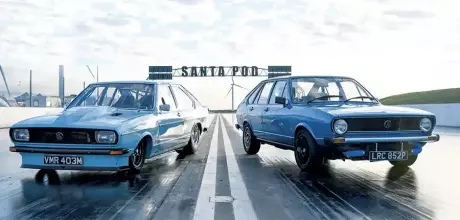1975 Volkswagen Passat 1.8T B1 and 1974 Passat V8 B1
With nine generations and 50 years on sale, the Passat has been a staple part of family life for millions of owners worldwide – but few have put that package through its paces quite as thoroughly as Rob and Hazel Carter.
Words: Alex Grant
Photos: Alice Fairhead
DRAG PASSATS – TWIN-TURBO V8 v 1.8T 20v
Husband and wife duo — We reveal the build story of this twin-turbo V8 and tuned 1.8T Passat

The Passat turned 50 last year and, although it’s often overshadowed by the Golf, it’s an been a bit of a trailblazer. Back in 1973, the B1 generation the first member of Volkswagen’s new front-engined, water-cooled line-up (the K70 it replaced was a re-badged NSU) and, with 34 million fi nding homes since, it’s gone on to outsell the Beetle. The ‘Passat’ a by-word for dependable and practical family motoring but, without the DTM or BTCC notoriety of its rivals, it’s less famed for its performance credentials. At least, not in factory spec.
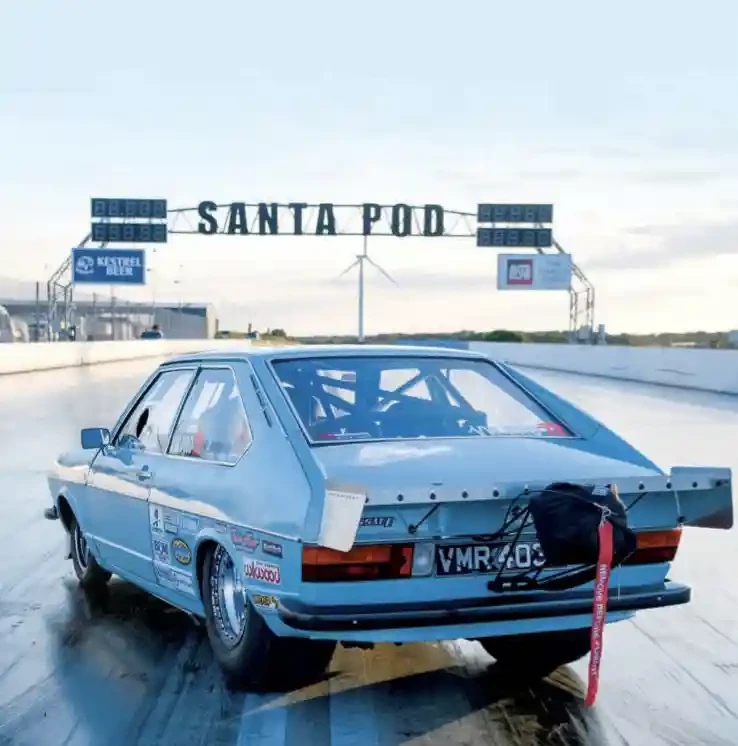
Within the ranks of the VWDRC, Rob and Hazel Carter are earning a very different reputation for the earliest Passat. Their sixyear overhaul of the B1 platform has resulted in two of the club’s best-known vehicles; a 1,200hp two-door saloon which has spent the last two seasons reliably putting down eightsecond quarter mile times, and a competitive four-door that’s starting to make its mark on the UK scene. Or Percy and Patricia, as most members know them.
“Rob’s mate Jonny came up with the name Percy, which stuck, then I followed the trendand named Patricia and we also have an ’83 called Perry,” laughs Hazel. “Rob refuses to call them by their names but he’s on his own there. Everyone else loves the names, which I think makes it even funnier.”
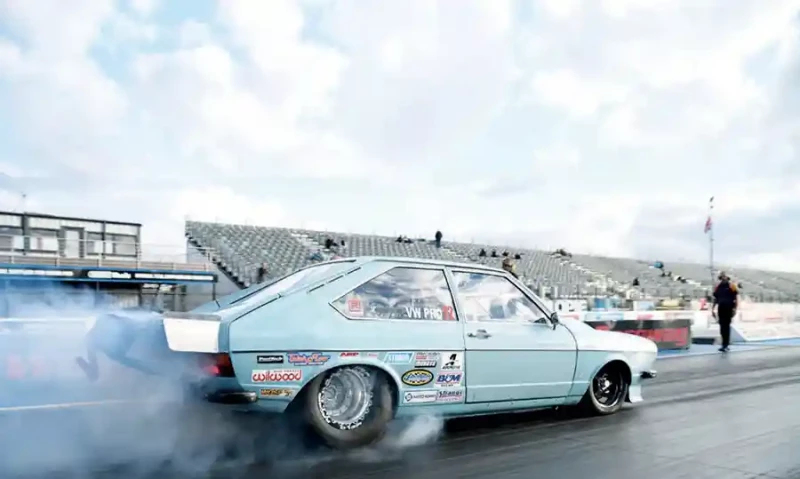
There are some solid foundations behind these home-grown dragsters. Although neither of the Carters work in the automotive trade – Rob co-owns a business specialising in moving bridges and ferry linkspans, and Hazel is a pharmaceutical clinical trials manager – both grew up in car-loving families and it’s set the stall for what’s come since. Rob spent some of his 20s as a sole trader building air-cooled Volkswagen and Porsche engines before moving into heavier machinery, then re-ignited similar interests in Hazel when they got together in the late ‘90s. Helping your future husband build a Lotus 7 kit car replica is a pretty hands-on way to sharpen your mechanical skills, but it’s drag racing that’s really stuck, as Rob explains.
«It sounded awesome, never went straight, and the sequential ‘box was epic»
“My first Beetle was a ’72 1300 running a 1776 engine and 50-shot of nitrous. I ran that in the VWDRC in 1999 or 2000 but only did one event at Bug Jam before money, time and life got in the way. Then I circuit raced motorbikes for a number of years, followed by cars when my body had had enough of bouncing off tarmac,” he smiles, adding that the Passat wasn’t top of the list when the strip started calling again.
“About eight years ago I wanted to get back into drag racing, so I was looking for an early 1960s Bug to turn into a drag car. I found a ’60 but it was too good to destroy – it had a JMR 1776 engine, Cogbox gearbox, Bernard Newbury interior and original magnesium BRM wheels – so I sold it a mate, who still has it.
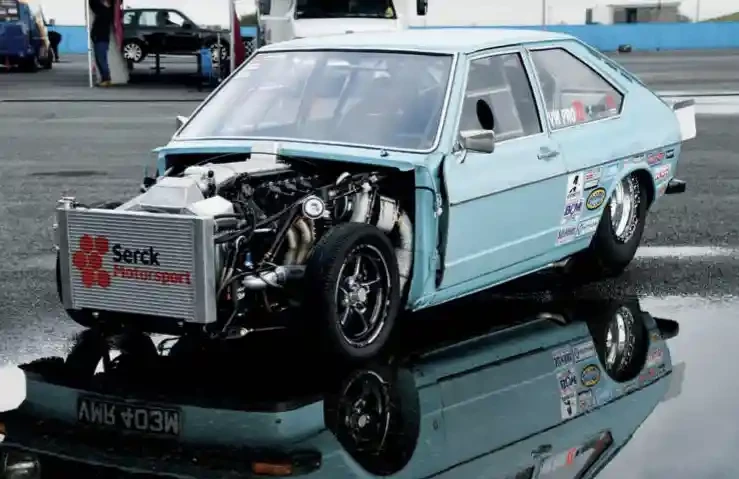
Then not long afterwards I saw the ’74 Passat on eBay and ended up buying that instead.” Although it seems a desirable base car, an early Golf might have sparked more of a bidding war. The Passat was an eye-catcher – an early 1.3-litre two-door saloon with 79,000km on the clock, already fitted with air-ride and 13x7-inch cross-spoke wheels – but it took three or four auctions to reach its reserve price. This was to be a promising start, and the car made it from London to its new home in Sheffield under its own steam. “It was a proper Euro lowrider,” he tells us. “The guy I bought it off had imported it from Sweden, so it was left-hand drive, and he’d driven it back to the UK using wooden blocks for front springs as the springs had snapped. I drove it as it was through the first summer, taking it to Volkswagen shows and getting quite a lot of attention. The plan was always to drag it, but I didn’t race it as it was.”
With no performance version to borrow from, the Passat was a reluctant race car. Later generations shared parts with the Golf, but the B1 is almost identical to the equivalent Audi 80 underneath. Its engine longitudinal and mounted ahead of the front axle, as you’d get in a modern A4, but there’s no provision for adding four-wheel drive as Syncro wasn’t available until the B2. A powerful engine swap would have created as many problems as it solved, so a competitive race car would require major surgery.
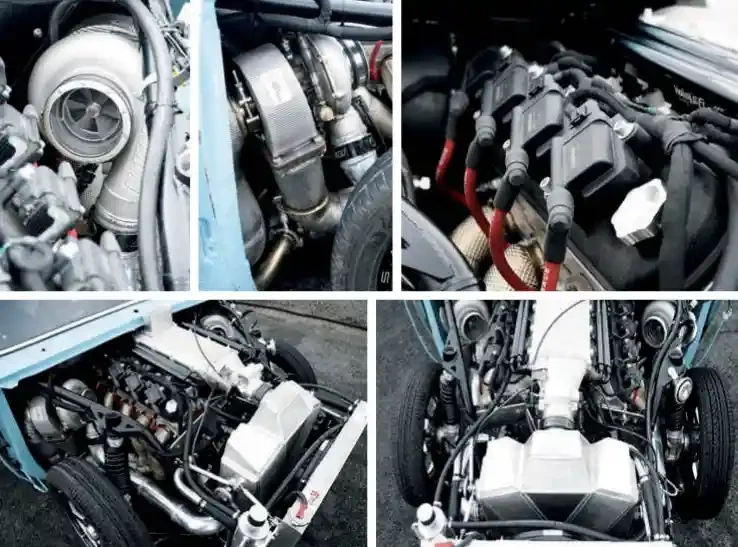
As you can probably tell by the skinny tyres, this one is no longer front-wheel drive. Rob started by stripping the shell back to its bare bones, fabricating a twin-rail frame to make space for the propshaft, then tubbed the arches for wider tyres and built custom turret tops for a bespoke suspension setup. Despite the familiar 1.8T swap, the spec sheet was dipping heavily into Ford’s parts bin. The Type 9 gearbox, shocks, hubs and steering column were a mix of Sierra and Capri parts, while the trailing arms were lifted from a Land Rover Discovery. It’s a lot of work, and it had potential beyond those original plans.
“I found a high-spec Norris Motorsport Cosworth YB engine on eBay, and I had to have it,” he tells us. “Hauser Race Cars built me a rear axle, based on a 9.0-inch Ford with a Strange Engineering spool and half-shafts, I bought a new Quaife 69G sequential gearbox, then I took it back to Norris for tuning. The engine revved to 8,000rpm, made around 600hp with a GT35 turbo and 50-shot of nitrous and it was a right laugh to drive. It sounded awesome, never went straight, and the sequential ‘box was epic.”

Epic, perhaps, but not quite enough to satisfy his mechanical curiosity. Having built a reliable ten-second drag car, Rob found himself getting sidelined by other projects which were edging closer to the performance of the main attraction. His single-turbo converted B5 Audi S4 Avant quickly powered itself into the 11s with input from John Sleath Race Cars, while an Ultima kit car was taking shape, slowly, behind the scenes. Frustrated by glacial progress with the latter, Rob started getting intrusive thoughts about slotting its supercharged V8 engine into the Passat instead.
The reality was nowhere near that simple. Already in touch with the team at John Sleath, Rob found discussions snowballing into a twinturbocharged LS V8 with a shell specced for eight-second ETs. Already on a roll, didn’t take long for Andy and Luke at Robinsons Race Cars to talk him into taking the next step – a full Unlimited class chassis, stitching the original bodywork from the A-pillar backwards onto a custom-built tubular frame. Anything else would have created a bottleneck when he inevitably wanted more power later on.
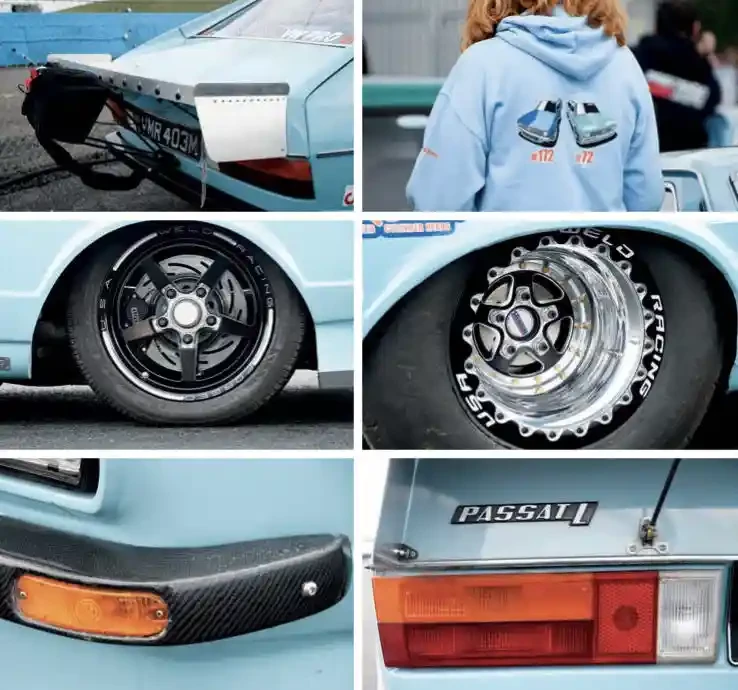
It's hard to get a feel for the sheer brutality on tap here until Rob and Hazel lift the front clamshell away from the frame. The John Sleath-built V8 is based on a 427 cubicinch (7.0-litre) Chevrolet LSX block, fitted with uprated stock-port RHS heads and a 102mm throttle body. Behind each of the front wheels is a Precision Turbo PT7875, feeding boost into a huge water-to-air intercooler mounted in the nose, while FuelTech FT600 management controls the car’s 16 injectors and inductive coils. The pipework, including the side-exit exhaust, was painstakingly fabricated at Robinsons Race Cars.
Naturally, there’s some heavy engineering helping to translate that over-boosted lunacy into brain-mashing straight-line speed. The engine is bolted to a Chevrolet TH400-style three-speed gearbox, built by John Sleath, which features straight-cut gears and a valve body that flips the linear shift pattern to avoid selecting reverse and enables ratios to be selected manually. At the back end is a GM 10.5-inch axle with a spool gear – effectively a permanently locked differential – with heavily-uprated driveshafts.
Entering the Street Eliminator class requires carefully selected chassis upgrades, as the car has to remain road legal. The Passat runs Strange Engineering adjustable shocks and a full set of Wilwood brakes behind the staggered Weld Racing Alumastar wheels – 12 inches wide at the back, and with 295mm of Mickey Thompson rubber to make sure all of that horsepower is put to good use. “It’s making nearly 1,200hp on the standard block and heads – and those are conservative real-world figures, not hyped-up dyno figures. The car weighs around 1,150kg so it’s around 1,100hp per tonne, but I have a Dart block and LS7 heads with mechanical lifters on the way. That should make over 2,000hp at 8,500rpm, which is closer to 1,800hp per tonne,” smiles Rob, adding that this couldn’t only work on the track.
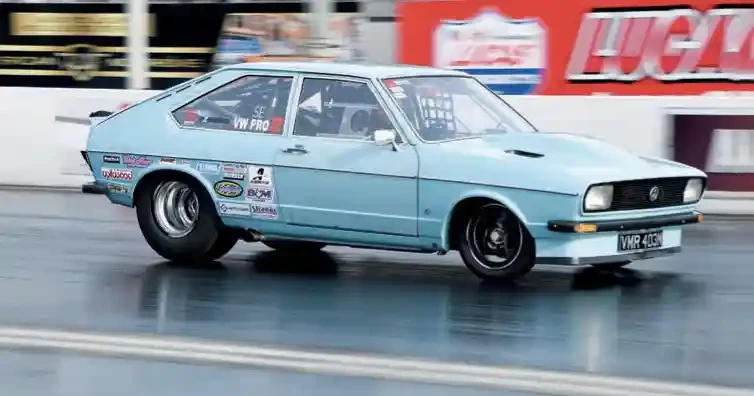
“It’s actually quite easy to drive on the road, and fairly comfortable except for the noise and heat. I covered nearly 500 miles doing the first UK drag weekend where we came third overall and were the quickest unsupported car.”
With that in mind, the visual overhaul is surprisingly subtle. The tucked tyres, rear spoiler and parachute (a requirement for cars this quick) are a giveaway, but it’s easy to overlook the extent of the work that’s gone into the build. Dig deeper and you’ll start to spot clever details throughout, such as the polycarbonate windows, carbon fibre bumpers and single-piece GRP front end custom-built by Craig Munro at Extreme Fibre. It’s all functional, but sympathetic to the Giugiaro-penned factory styling.
However, there’s no mistaking the built-for-purpose nature inside. Every plastic and fabric part has long gone, stripped back to a pair of RaceTech bucket seats (class rules, again), B&M shifter and Strange Engineering steering rack with the FuelTech display mounted on top. The high level of finish is a credit to Rob, who did most of the reassembly including wiring the car and plumbing in the brakes, radiator and breathers, then re-painted it in its original colour with the help of a friend.
It's been an effective package, too. Rob managed a personal best of 7.98 seconds at 171.1mph at Santa Pod last September, while qualifying for the Street Eliminator class at the FIA European Finals. Already a consistent performer, when he says low sevens are the plan next year, it’s hard to imagine the Passat will fall short. And it turns out that competitive streak is contagious, as Hazel explains.
“We bought the ’75 as a first car for our daughter, Olivia, a couple of years ago” she says. “This one was supposed to have stayed standard, but she wanted to race it and Rob said the easiest and cheapest thing to do was stick a 1.8T in it. However, she hasn’t been old enough to race until this year, so I jumped at the opportunity to use it instead. I love cars and driving and drag racing looked like fun… now I’m hooked on it too.”

«It drives much better than standard!»
It's had quite a change of pace compared to its previous life on the Isle of Wight. Patricia changed hands having covered only 33,000 miles from new, still in factory spec and never restored, but a good base for more power. The 163hp 1.8T was a £150 eBay purchase, lifted from a B7 Audi A4 and needing only a water pump and timing belt before it was put back into service. With custom driveshafts, a Holsett hybrid turbo and FuelTech ECU mapped by John Sleath, it’s put in a couple of seasons of sprints with only a few gremlins to iron out.
“The engine really suits the car, and it drives much better than standard. We’re only running around 10PSI of boost, so it’s making roughly 200hp, but with a couple of teething problems. When we fitted slicks it ate outer CV joints, so Rob uprated the hubs to V6 Audi Coupe parts and went back to radials. This then bent the lower wishbones, so he fabricated extra heavy-duty ones,” explains Hazel.

“So far, so good. It’s still running strong after two race seasons, but our continuing issue has been torque steer on the strip. It’s over 100mph at the top end, which should be a low 13-second ET, but with shocking traction – and, therefore 60-fts – its best is 14.4 seconds.” Just like its stablemate, the evolution is ongoing. Since the end of the 2023 season, Rob has swapped the original A4 gearbox for one from an early Porsche Boxster, as the two units have an identical casing. It’s a step towards solving some of the traction issues, enabling him to install a Quaife limited-slip differential benefit from stronger output shafts ready for more power. And more power is very much in the pipeline.
“I’ll be running the car in VWPRO this year, and we need to be hitting sub-12.99-second ETs,” explains Hazel. “Rob has bought an APX engine from an early 225hp Audi TT, which has a very strong bottom end, so we’ll fit that before the season begins and run 20 PSI of boost. That should be good for 300hp at 7,500rpm, and we’ll try slicks again with the stronger front end. It’ll also be running in VW Sportsman with Olivia at the wheel, on radial tyres and wastegate pressure.”
Taking down some of the more familiar performance-focused VW ought to help the early Passat shed even more of its understated image once Percy and Patricia roll back out of hibernation in 2024. Sure, factory models missed out on some of the motorsport credibility first time around, but it turns out there’s still room for the front-runner to blaze a trail at 50 years young.
DUB DETAILS 1975 VolkswagenPassat 1.8T B1
- ENGINE: 1781cc, 20-valve, turbocharged petrol from B7 Audi A4, Holset HX32 HE300 hybrid turbo, Tial 38mm external wastegate, cast inlet manifold machined and modified to fit turbo and wastegate, front-mount intercoler, 600cc injectors, Aeromotive Stealth in-tank fuel pump, FuelTech FT450 engine management supplied by ASD Ltd, Porsche Boxster 2.5-litre five-speed transmission, Quaife limited-slip differential, custom HD driveshafts, custom gear linkage
- CHASSIS: Audi Coupe V6 front struts and hubs, Audi Coupe 1.6 front discs and brake calipers, hubs and discs re-drilled to 4x100 stud pattern, custom-made lower wishbones, 10.0-second roll hoop by Robinsons Race Cars, 15x8 Compomotive MO wheels with 205/50 Nankang AR-1 tyres (front), 14x6 BBS RJ wheels with 195/65 Nankang NA-1 tyres (rear)
- EXTERIOR: Factory bodywork
- INTERIOR: Sparco Sprint driver’s seat, Mk2 Golf GTI passenger seat, rear seats removed
- SHOUT: Rob – for building most of the car at Home
DUB DETAILS 1974 VolkswagenPassat V8 B1
- ENGINE: John Sleath Racing engine, 427c.i. Chevrolet LSX cast iron block (4in stroke, 4.125in bore), Diamond pistons, Boostline conrods, RHS LS3 heads with stock ports, lifters and followers, uprated valves with twin HD springs, COMP Cams JSR Racing-spec camshaft, 2x Precision PT7675 turbos with 38mm wastegates, Custom Robinson Race Cars water-to-air charge cooler, Holley Lo-Ram inlet manifold with 16 injectors and 102mm throttle body, Vibrant Performance PINLESS clamps, Aeromotive 10.0 GPM brushless two-speed fuel pump, FuelTech FT600 engine management and FuelTech Boost control solenoid supplied by ASD Ltd, FuelTech coils, Serck Motorsport radiator, Chevrolet TH400 three-speed gearbox built by John Sleath Racing, heavy-duty straightcut gearset, reverse-pattern manual valve body, CK Performance Pro transbrake, Pro Mod drum and billet hub, external transmission cooler and pressure dump, Robinsons Race Cars rear axle and converter, Neal Chance bolt together custom converter, Strange Engineering 10.5in spool and 3.4:1 gear ratio, custom fabricated housing, Strange Engineering HD Pro aluminium case third member, Strange Engineering 40-spline shafts
- CHASSIS: Custom full-frame SFI 25.1-spec (unlimited) chassis by Robinsons Race Cars with four-link rear, Strange Engineering shocks (single adjustment front, double adjustment rear), Wilwood four-pot calipers on discs all round, Strange Engineering steering rack,15x3.5 (front) and 15x12 (rear) Weld Racing Alumastar wheels, 145/65 Nankang AS-1 tyres (front), 295/65 Mickey Thompson ET Street tyres (rear), parachute
- EXTERIOR: Original ’74 steel body with fibreglass front and custom aluminium spoiler, carbon fibre bumpers, polycarbonate windows
- INTERIOR: RaceTech seats with TRS harnesses, Momo steering wheel, FuelTech FT600 display, B&M shifter, Wilwood pedal box
- SHOUT: John Sleath, Andy and Luke Robinson, Trevor and Steve at ASD
«This one was supposed to have stayed standard, but she wanted to race it and Rob said the easiest thing to do was stick a 1.8T in it»


